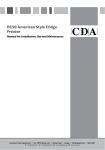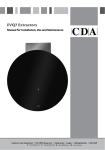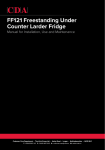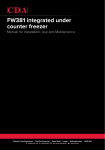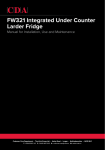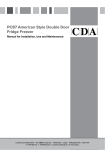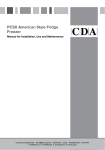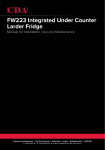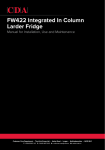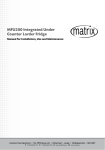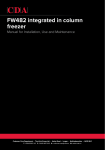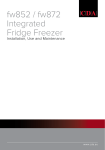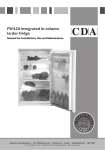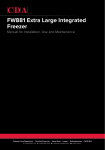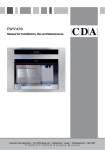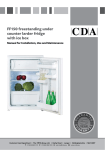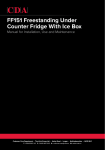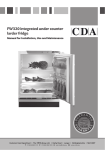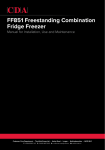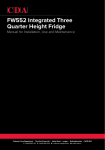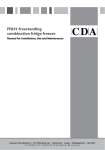Download CDA FW821 refrigerator
Transcript
FW821 Extra Large Integrated Larder Fridge Manual for Installation, Use and Maintenance Customer Care Department • The Group Ltd. • Harby Road • Langar • Nottinghamshire • NG13 9HY T : 01949 862 012 F : 01949 862 003 E : [email protected] W : www.cda.eu Important The manufacturer cannot be held responsible for injuries or losses caused by incorrect use or installation of this product. Please note that we reserve the right to invalidate the guarantee supplied with this product following incorrect installation or misuse of the appliance. This appliance is not designed to be used by people (including children) with reduced physical, sensorial or mental capacity, or who lack experience or knowledge about it, unless they have had supervision or instructions on how to use the appliance by someone who is responsible for their safety. Under no circumstances should any external covers be removed for servicing or maintenance except by suitably qualified personnel. Appliance information: Please enter the details on the appliance rating plate below for reference, to assist CDA Customer Care in the event of a fault with your appliance and to register your appliance for guarantee purposes. Appliance Model Serial Number CE Declarations of Conformity: This appliance has been designed, constructed and marketed in compliance with safety requirements of EEC Directive 2006/95/EEC (Low voltage) and requirements of EMC Directive 2004/108/EEC. 2 This appliance has been manufactured to the strictest standards and complies with all applicable legislation, including Electrical safety (LVD) and Electromagnetic interference compatibility (EMC). Parts intended to come into contact with food conform to EEC/89/109.4 IMPORTANT INFORMATION FOR CORRECT DISPOSAL OF THE PRODUCT IN ACCORDANCE WITH EC DIRECTIVE 2002/96/EC. At the end of its working life, the product must not be disposed of as urban waste. The refrigeration system contains insulating gases and refrigerants, which require specialised waste disposal. The valuable materials contained in this appliance can be recycle. It must be taken to a special local authority differentiated waste collection centre or to a dealer providing this service. Before disposing of an old appliance, remove the door seals, latch or bolt lock to avoid the risk of child entrapment. Disposing of a household appliance separately avoids possible negative consequences for the environment and health deriving from inappropriate disposal and enables the constituent materials to be recovered to obtain significant savings in energy and resources. As a reminder of the need to dispose of household appliances separately, the product is marked with a crossed-out wheeled dustbin. 3 Before first use You must allow the fridge to settle for at least twenty four hours prior to switching the power on. It is recommended that you clean the interior of the appliance prior to first use, using a solution of bicarbonate of soda and warm water and then thoroughly drying the interior. The fridge may have an odour to it at first use. This will disappear as the appliance cools. Do not load the fridge with food until at least 2 hours have passed and the fridge is close to correct temperature. Please note: • The appliance will work continuously until it comes down to the correct temperature. • If the appliance is switched off, you should allow five minutes before switching it on again to prevent unnecessary damage to the compressor. • This fridge cools your food by making the inside back of the cavity cold. It is normal for frost to build up on this surface; it then dissipates and drains through a small drain at the bottom, where it evaporates harmlessly. The presence of frosting at the back is not a malfunction of the fridge. Defrosting the fridge The fridge is self-defrosting. Any water created will run out of the fridge through the channel at the back of the fridge. It is important to keep the channel clear at all times. The defrosted water is collected in the evaporating tray at the back of the appliance. 4 fig. 1 Use • Never put liquids in the refrigerator uncovered. • Never put hot foods in the refrigerator. Warm food should be allowed to cool to room temperature before being put into the refrigerator. • Nothing should rest against the internal rear wall of the refrigerator, as this will cause frost and possible condensation problems which will be difficult to remove. Setting the temperature You must allow the fridge to settle for at least twenty four hours prior to switching the power on. The fridge will take some time to adjust to the new settings. This will depend on the difference between the old and new settings, the ambient temperature, the amount of food in the fridge and the number of times the door is opened. To adjust the temperature turn the thermostat control knob clockwise (from off) to the required level. The temperature becomes colder the higher the number on the control. 5 We recommend initially setting the temperature control in mid range for the first 24 hours then adjusting the temperature up or down from this point as your personal preference. Care and cleaning Always disconnect the appliance from the power before any cleaning or maintenance. • The refrigerator should be cleaned using a solution of bicarbonate of soda and lukewarm water. • Do not use abrasive products or detergents. After washing, rinse and dry thoroughly. • Clean the shelves and balconies separately by hand using soap and water. Do not put them in the dishwasher. • The evaporating tray and water drain hole (at the back of the compartment) should be cleaned periodically to prevent the defrosted water from collecting inside the compartment. The drainplug can be used to clear the drain hole. • Once cleaning is complete, reconnect the mains power supply. • If the appliance is not used for prolonged periods of time or in the event of a prolonged power cut unplug and clean the appliance. The doors should be left slightly open to prevent the formation of mildew and smell. • The door seal should be cleaned periodically. • Clean the switch, lamp and thermostat control with a dry cloth. 6 Troubleshooting If you have any problems with your appliance, you should check the troubleshooting prior to calling CDA Customer Care to prevent unnecessary service calls and potential cost. If the appliance is not working • Check there is power to the appliance. • The house fuses are intact and the fuse in the plug has not blown. • The thermostat is not set to 0 (off position). • The plug socket is functioning fine. To check this, plug another electrical appliance in to see if the socket is working. • The temperature of the room is adequate (10°C or above). If the appliance is working, but not very well • The appliance is not overloaded. • The thermostat is set to an appropriate temperature. • The door is closing properly. • The cooling system at the rear of the appliance is clean and free of dust, and not touching the rear wall. • There is enough ventilation at the side and rear walls. • The temperature of the room is adequate (10°C or above). If the appliance is noisy • The appliance is level and stable. • The side and rear walls are clear, and there is nothing resting on the appliance. • The cooling gas in the refrigerator will make a slight bubbling noise, even when the compressor is not running. 7 If there is water in the lower part of the refrigerator compartment • The drain hole in the channel at the back of the compartment is clear. Please note: The LED lighting cannot be replaced without a service call. If the light fails, contact CDA Customer Care. Installation And Ventilation This appliance must never be installed close to heat sources i.e. heating elements, cookers or in damp places The diagram shows the ventilation requirements for your product. Failure to provide adequate ventilation can lead to increased running costs and premature failure and may invalidate the warranty provided with the product. 560-570 545 min 545 57 17701788 1770 min. 30 45 540 = airflow fig. 2 8 Ventilation The main consideration when installing any refrigeration unit into a fitted kitchen is ventilation. The heat removed from the cooling compartment needs to be dissipated into the atmosphere. Incorrect ventilation can lead to premature compressor failure, excessive power consumption and total system failure. For products intended to be installed into a tall housing unit, the following requirements need to be met: Important Please follow the instructions to install this unit An air intake should be provided somewhere in the cabinet run to allow free air in. In this example, a plinth vent is shown underneath the refrigerator . The top of the cabinet needs to be vented into the room Refrigerator outline Recommended size of vent opening: 500 x 35mm If the furniture does not allow free air into the room then a plinth vent, or other means of ventilation needs to be provided to ensure a natural flow of air A thin section of the plinth can be removed to allow air into the unit (recommended 600mm x 10mm) Min 30mm There should be space at the rear of the cabinet to allow cool air to be drawn over the condenser. Recommended: 500 x 35mm 300 300 plan view of cut out and ventilation gaps A hole should be cut in the supporting shelf, as shown below fig. 9 9 The open channel at the rear is clearly shown. For the correct operation of the appliance it is important that the top of the housing unit is not blocked off. A channel depth of 40-50mm is normal with most units. A hole is shown in the base shelf of the unit; this allows air to be drawn over the compressor & heat exchange. Some installers fit a decorative plinth vent. In most cases this is not required, but is a welcome aesthetic addition. As a rule, the more air can get in, the better and more efficient the operation of the product. 10 Reversing the door fig. 4 It is possible to reverse the door on this appliance, if required. To do so, follow the steps below: 1. L oosen the top hinge fixing screws and remove the top hinge, taking care to support the weight of the door. 2. Lift the door from the bottom hinge and place on a soft surfaceto protect the door from damage. 3. R efit the hinge taken from the top to the opposite lower corner, as in figure 4. 4. R eplace the door and refit the hinge taken from the lower corner to the opposite top corner. 5. Adjust the hinges to ensure the door is aligned correctly. 11 Mounting the Fascia Door • Using a screwdriver, fix the mounting brackets to the appliance door, as shown in figure 5. • Position the appliance within the unit. Ensure that there is a gap of 3 to 4 mm between the non-hinged side and the cabinet wall. • Locate the slider in the bracket and fix the slider to the fascia door 20 to 22 mm from the edge of the fascia as shown in figure 5, ensuring that the slider is positioned centrally and horizontally within the bracket. Tighten securely by hand. • Fill the gap on the non-hinged side with the seal strip provided, as shown in figure 6. x4 fig. 5 x4 20 mm fig. 6 door gasket 12 fig. 7 Electrical Iinformation Warning! This appliance must be earthed. Green and Yellow to Earth A 13 Amp Brown to Liv e B 13 Amp fuse Cord Clamp fig. 13 Blue to Neutra l The mains lead of this appliance has been fitted with a BS 1363A 13Amp fused plug. To change a fuse in this type of plug, follow the steps below: 1. Remove the fuse cover and fuse. 2. Fit replacement 13A fuse, ASTA approved to BS 1362 type, into the fuse cover. 3. Replace fuse cover. Important: Do not use the appliance without the fuse cover in position. How to connect an alternative plug If the fitted plug is not suitable for your socket outlet, then it should be cut off and disposed of safely to avoid possible shock hazard. A suitable alternative plug of at least 13 Amp rating to BS 1363 should be used. 13 As the colours of the wires in the mains lead of this appliance may not correspond with the coloured markings identifying the terminals in your plug, proceed as follows:• The wire which is coloured GREEN and YELLOW must be connected to the terminal which is marked with letter (E) or by the Earth symbol or coloured GREEN and YELLOW. • The wire which is coloured BLUE must be connected to the terminal which is marked with the letter (N), or coloured BLACK. • The wire which is coloured BROWN must be connected to the terminal which is marked with the letter (L) or coloured RED. If in doubt regarding the electrical connection of this appliance, consult a qualified electrician. Do not shorten the supply cable, the appliance may require removing for servicing. N.B. Ensure that the plug socket is situated in an easily accessible place after installation. 14 15 Please contact our Customer Care Department for Service on the details below Customer Care Department • The Group Ltd. • Harby Road • Langar • Nottinghamshire • NG13 9HY T : 01949 862 012 F : 01949 862 003 E : [email protected] W : www.cda.eu
















